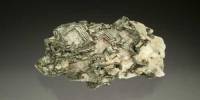Niobium phosphide is an inorganic compound of niobium and phosphorus with the chemical formula NbP. It is an interesting material with a range of unique properties. It is a binary compound composed of niobium (Nb) and phosphorus (P). It crystallizes in a cubic lattice structure, similar to the structure of other transition metal phosphides. It is a good conductor of electricity, and it exhibits metallic conductivity.
The compound is a unique material combining topological and conventional electronic phases. Its superfast electrons demonstrate extremely large magnetoresistance, so NbP may be suitable for use in new electronic components.
Properties
Niobium phosphide, like tantalum arsenide TaAs, is a topological Weyl semimetal. It does not dissolve in water. It can exhibit quantum oscillations, which are phenomena related to the interaction of the electronic bands with magnetic fields. It has good thermal stability, though precise thermal properties like thermal conductivity aren’t as commonly detailed as for some other materials.
- Chemical formula: NbP
- Molar mass: 123.88
- Appearance: Dark-gray crystals
- Density: 6,48 g/cm3
- Solubility in water: Insoluble
- Crystal structure: Tetragonal
Electronic Properties
NbP is known for its unusual electronic properties. It is a type of topological semimetal, meaning it has a special electronic band structure where the conduction and valence bands touch at discrete points known as Dirac or Weyl nodes. This results in high mobility of charge carriers, which can lead to interesting transport properties.
Niobium phosphide is generally stable in air but can react with strong acids and bases. It is more resistant to oxidation compared to some other phosphides. It is known to be hard and brittle, which makes it useful in some high-stress applications but also limits its workability.
Uses
The compound is a semiconductor used in high power, high frequency applications and in laser diodes. The unique properties of NbP make it a subject of interest for various advanced technological applications. Its high mobility and potential for manipulation in quantum computing and other electronic devices make it a candidate for research in cutting-edge technologies.
















